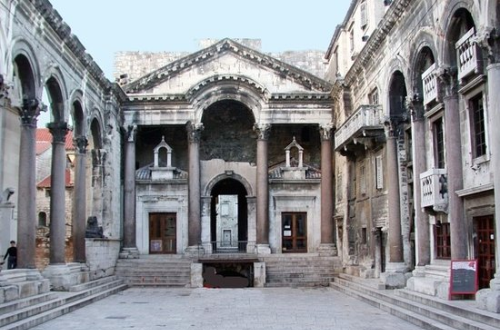

 Split
SplitOur travels now took us firstly to Split which is the location of the Roman emperor Diocletian's Palace completed in AD305. Diocletian built the city as a place he could retire to and he spared no expense, as you can see from the image, importing marble from Italy and Greece, and columns and sphinxes from Egypt.
The palace was built from lustrous white stone from the island of Brac and it took around 10 years to build. Although it's a UNESCO 'World Heritage Site' it is also a living city and there don't appear to be too many constraints on what the locals can do as we were amazed to see kids kicking a football about the ancient ruins. I can't see this being allowed to continue indefinitely if this city is to be preserved for future generations. As you can see from the illustration it was a fine example of Roman construction in its day.
We saw the impressive Cathedral of Saint Domnius, built in AD 305 and consecrated at the turn of the 7th century, which is regarded as the oldest Catholic cathedral in the world that remains in use in its original structure without major renovation at a later date; the bell tower (dedicated to Saint Domnius) dates from the 12th century.
The water at the front of the palace has been pushed back and now you can walk along the fine promenade (riva) between the old walls and the water's edge and sample the many restaurants and bars, which of course we did!! The local guide was singularly unimpressed with the ultra-modern lamposts and gazebo supports on the promenade against the background of the old palace walls but gave us a well informed tour of Diocletians palace.
There was a local 'quartet' singing 'a Capella', that is with no musical accompaniment, proved remarkably good and got a well deserved round of applause as well as a few takers for their CD's.
There's an iconic clock in the old town (see illustration) which I think explains why there were a number of traders along the Riva selling clocks although they were not really in the style of the old clock!
The palace gate was guarded by two roman soldiers; it's been said that Croatians are a tall race and as you can see from the photo, Jane barely reached his waist (LOL).
 Trogir & Voldici
Trogir & VoldiciFrom Split we carried on to Trogir, which is a small medieval town and harbour with a population of approximately 13,000. As with many other places we visited it is on the UNESCO World Heritage List as it is one of the best preserved medieval towns in Europe. It is also very popular with wealthy visitors in their yachts who are able to moor up on the very attractive quayside. Our guide was born on this island and showed us the primary school he attended which appeared to be not much more than a room over a cafe.
I read up a bit on this town afterwards as it seemed to be a lot more than we got to see and in fact there are many places that were unable to visit as we were on foot, including many beaches, galleries and a fortress. We did get to see the spectacular Venetian Cathedral of St. Lovro which was built on the foundations of an early-Christian cathedral destroyed in 1123 during the sack of the town by the Saracens. The building of the cathedral began in 1213 and finished during the 17th century. Like the older one, it is also dedicated to St. Lawrence (Sveti Lovro) but it is better known as St. John's Cathedral (Sveti Ivan). We also saw the Church of St. John the Baptist with its superb carved portal.
That evening we travelled to a small seaside village called Vodice and stayed at the Hotel Punta. Much to our amazement as we walked to the lift who should come out of it but Eric Cantona who was staying there whilst he took part in his latest film. The receptionist said that he was learning Croatian for the film and was staying there for around six months. We had a great view from out hotel window as the night drew in and the sky changed from light to red to dark.